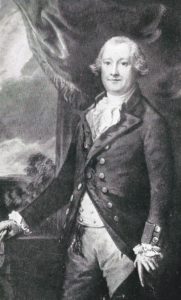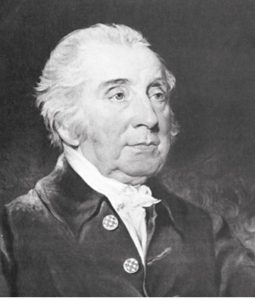Lord Derby & Sir Charles Bunbury
Mobiles view Landscape
 Edward Smith-Stanley, 12th Earl of Derby (1752-1834), on becoming of age, bought a country house, at Woodmansterne, near Epsom, called ‘The Oaks’, from his uncle by marriage, General John Burgoyne. For the Epsom May Meeting in 1778, Lord Derby, a steward, invited a party of friends to his house, where it was proposed that the following year, a single race over one and a half miles for three-year-old fillies would add some spice to the meeting. The race was named after Lord Derby’s house and appropriately, won by his filly, Bridget. The event was considered a great success and as a result, another new race was proposed, this for both colts and fillies, to be run over a mile the following year – but what to call it – “The Bunbury” or “The Derby” – they tossed a coin and, “Heads it is, so it’s The Derby – The Derby Stakes.”
Edward Smith-Stanley, 12th Earl of Derby (1752-1834), on becoming of age, bought a country house, at Woodmansterne, near Epsom, called ‘The Oaks’, from his uncle by marriage, General John Burgoyne. For the Epsom May Meeting in 1778, Lord Derby, a steward, invited a party of friends to his house, where it was proposed that the following year, a single race over one and a half miles for three-year-old fillies would add some spice to the meeting. The race was named after Lord Derby’s house and appropriately, won by his filly, Bridget. The event was considered a great success and as a result, another new race was proposed, this for both colts and fillies, to be run over a mile the following year – but what to call it – “The Bunbury” or “The Derby” – they tossed a coin and, “Heads it is, so it’s The Derby – The Derby Stakes.”
Although now best known for his connection with the race, in his lifetime he was celebrated as the champion cockfighter of all England – then the National sport, breeding and fighting with his own strain of game cocks known as the Knowsley Breed.
In 1774, Edward Stanley married Lady Elizabeth Hamilton. It was not, however, a lasting relationship. At a summer house party in 1777, a cricket match took place between two local teams, during which the Duke of Dorset gave an impressive display. A second game followed, where in the interval Lady Elizabeth took her lady guests on to the field to meet the players – two years later, Lady Elizabeth, now a mother of three, absconded abroad with her cricketing hero. In the scandal that followed, Lord Derby refused to divorce her, eventually taking solace in the company of Elizabeth Farren, a famous actress playing the part of Lady Teazle in Sheridan’s popular play, The School for Scandal. In 1797, soon after the death of Lady Elizabeth, Lord Derby married Elizabeth Farren. Smitten, he named two of his mare Papillon’s produce Lady Teazle and Sir Peter Teazle, after characters in the play. The success of the Teazle’s on the stage was matched by their success on the turf – Lady Teazle was second in the Oaks and Sir Peter Teazle won the Derby on his first racecourse appearance.
 Sir Thomas Charles Bunbury (1740-1821), was the son of a vicar at Great Barton, near Newmarket. He was elected a Whig MP for Mildenhall, Suffolk, at the age of 21 and became a strong opponent of the slave trade. He was the first outstanding member of the Jockey Club and became a senior Steward at the age of 28, thereafter taking the role of ‘perpetual president’. However, like the Earl of Derby, he too was subject to a scandal. After his marriage to the notorious Lady Sarah Lennox in 1762, she had an affair with Lord William Gordon, giving birth to his daughter. The couple eloped taking the child with them, but when Lord William abandoned her, Sir Charles refused to take her back.
Sir Thomas Charles Bunbury (1740-1821), was the son of a vicar at Great Barton, near Newmarket. He was elected a Whig MP for Mildenhall, Suffolk, at the age of 21 and became a strong opponent of the slave trade. He was the first outstanding member of the Jockey Club and became a senior Steward at the age of 28, thereafter taking the role of ‘perpetual president’. However, like the Earl of Derby, he too was subject to a scandal. After his marriage to the notorious Lady Sarah Lennox in 1762, she had an affair with Lord William Gordon, giving birth to his daughter. The couple eloped taking the child with them, but when Lord William abandoned her, Sir Charles refused to take her back.
Thereafter, he gave more time to Parliament and the Turf, and although losing the legendary coin toss to name the race, Sir Charles had the pleasure of owning the first Derby winner – Diomed. He also owned Eleanor (1801), the first filly to win both the Derby and the Oaks, and Smolensko (1813), the first horse to win both the Two Thousand Guineas and the Derby. Famously, he also bred Highflyer (b.c. 1774), by Herod ex Rachel by Blank, who was never beaten on the racecourse and the Champion Sire 13 times. It was during his reign at the Jockey Club that the five Classic races were formed, a pattern, that in time, would be replicated around the world. Without doubt, on the Turf, Sir Charles was the most influential man of his age.
If you enjoy racing’s history, take a look at Michael’s new list of BOOKS FOR SALE